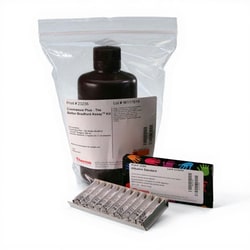Learn More
Thermo Scientific™ Pierce™ Bradford Plus Protein Assay Kits
Tienda Thermo Scientific ProductosDescripción
The Pierce Bradford Plus Protein Assay Kit is a ready-to-use, reducing agent-compatible, improved Bradford assay reagent used to quickly measure total protein concentration compared to a protein standard. It provides increased linearity and half the protein-to-protein variability of other commercial Bradford assay formulations.
Kits are available with or without Pierce Dilution-Free BSA Protein Standards, which are a set of seven pre-diluted BSA standards, packaged in a multichannel pipette-friendly tubestrip. The tubestrip includes a single empty tube that enables users to add their own sample buffer for the purpose of blank subtraction.
Características destacadas:
Colorimétrico: medición con un espectrofotómetro estándar o lector de placas (595 nm).
Fácil de usar: un solo reactivo, no es necesaria la preparación de un reactivo de trabajo
Rápido: desarrollo prácticamente inmediato del color; agregar, mezclar y leer los resultados
Intervalo amplio: detecta la concentración de proteínas en un intervalo de 1 a 1500 μg/ml
Mejor: uniformidad de respuesta y linealidad mejoradas en comparación con las formulaciones de Bradford tradicionales
Flexible: con las instrucciones, se suministran protocolos de microplaca y cubeta adaptables a diversas gamas de trabajos diana.
Incluye:
El kit contiene un reactivo de ensayo de proteínas y 10 ampollas de patrón de albúmina

Especificaciones
Especificaciones
| Concentración | BSA: 2 mg/mL |
| Contenido y almacenamiento | Suficiente para: 630 ensayos de tubos o 3160 ensayos de microplacas • Reactivo de ensayo Pierce Coomassie Plus, 950 ml • Ampollas de patrón de albúmina, 2 mg/ml, 10 x 1 ml Almacene el reactivo de ensayo Coomassie Plus a 4 °C. Almacene las ampollas de patrón de albúmina sin abrir a temperatura ambiente. |
| ensayo | Ensayo de Bradford |
| Método de detección | Colorimétrico |
| Línea de productos | Pierce |
| Tipo de producto | Ensayo de cuantificación de proteínas |
| Especificidad | Sin especificidad |
| Suficiente para | 630 ensayos en tubo o 3160 ensayos en microplaca |
| Para utilizar con (aplicación) | Detección basada en soluciones, absorbancia |
| Para utilizar con (equipo) | Espectrofotómetro, lector de microplacas |
| Mostrar más |
Seguridad y manipulación


- COOMASSIE PLUS PROTEIN ASSAY KIT
- Peligro
- Corrosión o irritación cutáneas Categoría 1B
- Lesión ocular grave/irritación ocular Categoría 1
- Toxicidad específica en determinados órganos tras una exposición única Categoría 2
- H314-Provoca quemaduras graves en la piel y lesiones oculares graves.
- H371-Puede provocar daños en los órganos.
- P280-Llevar guantes/prendas/gafas/máscara de protección.
- P260-No respirar el polvo/el humo/el gas/la niebla/los vapores/el aerosol.
- P304+P340-EN CASO DE INHALACIÓN: Transportar a la persona al aire libre y mantenerla en una posición que le facilite la respiración.
- P301+P310-EN CASO DE INGESTIÓN: Llamar inmediatamente a un CENTRO DE TOXICOLOG A/médico/.
- P331-NO provocar el vómito.
- P303+P361+P353-EN CASO DE CONTACTO CON LA PIEL (o el pelo): Quitar inmediatamente todas las prendas contaminadas. Aclararse la piel con agua/ducharse.
- P311-Llamar a un CENTRO DE TOXICOLOG A/médico/.
- P305-EN CASO DE CONTACTO CON LOS OJOS:.
- P310-Llamar inmediatamente a un CENTRO DE TOXICOLOG A/médico/.
- P501-Eliminar el contenido/el recipiente en .
- MIXTURE LIST-Contém: Phosphoric acid, Methyl alcohol
Para uso exclusivo en investigación.
Proporcione sus comentarios sobre el contenido del producto rellenando el siguiente formulario.
